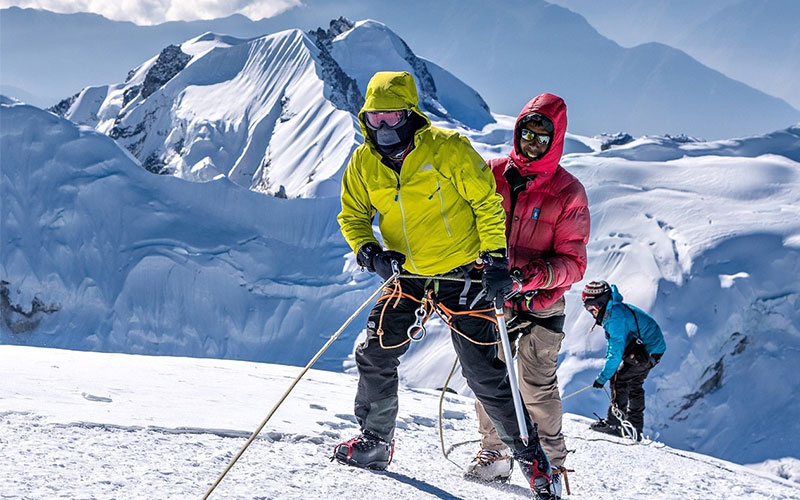Ever since J.O.M. Roberts and Sen Tenzing’s successful trek to Mera Peak in May 1953, mountaineers and adventurers alike have highlighted this peak as a must-climb. This thrilling journey across the Solu region’s Himalayas has gained increasing traction in October. October offers a unique experience for those who wish to climb Mera Peak because the month enchants climbers with its unmatched beauty and challenges them to go beyond their comfort zones.
At 6461 meters (21197 feet), Mera Peak, rising from the south of Everest and tucked into the integrity of the Hinku and Honku valleys, has been thumbing with glory. Classified as a trekking peak, ascending Mera peak in October will transport you to a pristine Himalayan region that provides you with breath-taking views of stunning landscapes and some of the highest peaks on Earth.
October’s climb of Mera Peak starts with a picturesque flight from Kathmandu to Lukla. To get to Kharka, you will travel through the paths that traverse Zatrawala traverse. You will eventually reach Mera High Camp after passing Thangnak and Khare on the hike. You’ll exert yourself to reach the top of Mera Peak, where you’ll be rewarded with sweeping vistas of the mountains all around you. Conquering the Himalayas in a matter of weeks is a significant accomplishment for the mountain expedition.
Highlights
- Take control of the Mera Peak peak.
- sweeping A view of the world’s five tallest peaks: Cho Oyu (8,201 meters), Makalu (8,481 meters), Kanchenjunga (8,586 meters), Lhotse (8,516 meters), and Mount Everest (8,848 meters).
- Take a stroll along the unspoiled paths in Hinku Valley.
- Take an exciting flight from Kathmandu to Lukla to begin your trip.
- Recognize the distinctive customs and culture of the Sherpa people.
- Get a sense of satisfaction after completing some of the challenging passes.
- Vast meadows with pristine Himalayan views, charming rivers and waterfalls, and thick rhododendron, pine, and fir woods
What Will The Weather And Climate Be Like While Mera Peak Climbing in October?
Climbing Mera Peak is the perfect blend of excitement and simplicity. You will go through the foothills for a while before reaching the foot of Mera summit. After taking the weather into consideration, you will climb to the summit. Therefore, while trying to reach the peak of Mera Peak, it is crucial to ascertain the weather and climate.
October will have steady weather and a lovely climate that will make climbing more enjoyable. The monsoon rains will remove the clouds and mists, resulting in lower humidity levels and more comfortable weather. Average daily temperatures in the lower elevation of the Everest region range from 14 to 20 degrees Celsius, while nighttime temperatures range from 10 to -5 degrees Celsius. Nonetheless, you will notice a noticeable dip in temperature as you ascend to a higher altitude. During the day, the high mountain’s temperature can fluctuate from 8 to -10 degrees Celsius. Similarly, near the top of Mera peak, the temperature might plummet to much lower negative numbers.
With an average of ten hours of sunlight, the day will be mild but the mornings and evenings will still be very cool. In addition, the daytime crisp air will relieve all of the fatigue from lengthy hiking days.
Why to do Mera Peak Climbing In October?
Pleasant Weather Condition
October is known for having consistent, nice weather. With moderate daytime temperatures, it provides an ideal environment for hiking and climbing. Furthermore, climbers can spend more time exploring the side highlights of their adventure because there are more hours of sunlight during the day. Higher elevations might have frigid temperatures, although this is readily tempered by dressing in layers. Thus, if you choose to attempt climbing Mera Peak in October, make sure you are well-prepared.
Dry Trails
The dry trails are a major benefit to hiking Mera Peak in October. October brings dry conditions to Mera Peak trails, making access to the climb simple. Additionally, dry walkways make it easier to navigate the course. Although there is snow in the ascending areas, October sees little snowfall, so the climb is not too difficult.
Clear And Wide Visibility Of Himalayan Vista
October’s shift from intense monsoon rains to fall will significantly reduce the amount of humidity in the atmosphere, producing dry air. Currently, October’s air is less humid, which prevents clouds from developing in the sky. You won’t have any trouble seeing the mountain ranges while hiking if there aren’t any clouds or haze. You will forget all the exhaustion of the journey when you see Everest, Cho Oyu, Lhotse, and other nearby peaks sparkling with snow beneath a clear blue sky.
Additionally, it will be quite helpful throughout the ascent as the clouds won’t impede your eyesight, making it easier for you to negotiate the snowy roads. Simultaneously, the refreshing wind in a relatively cool environment is like frosting on the cake when hiking Mera Peak in October.
More Cultural Exploration Opportunity
Climbing Mera Peak in October is an entertaining experience that will help you better comprehend Nepalese customs and culture. In Nepal, the fall is typically regarded as the main celebration season. In addition, October marks the two largest festivals, Dashain and Tihar, as well as a number of other celebrations, including Chaith and Indra Jatra.
Thus, during your journey, you can take in the cultural processions and purify your taste with a variety of local cuisines. Your entire climbing experience will be invigorated and your attitude will be elevated by these festival spirits.
Low Probability Of Rainfall And Snowfall
On the paths of Mera Peak, the dry season also begins in early October. The likelihood of precipitation and rainfall will be extremely low. This will increase the climbers’ overall safety and give them more self-assurance to reach the peak. The Mera peak adventure will be much easier because there will be less likelihood of unfavorable weather. There will be relatively little chance of weather-related incidents like avalanches and slick trails. Climbers will also find the lovely atmosphere to be a rewarding characteristic.
Nothing Beats Photography This Season
Climbing Mera Peak in October is like to painting a stunning picture with an array of hues, patterns, narratives, and methods. The pristine snow-capped mountains are the backdrop for the autumn foliage’s playful interplay of light and shadow. Additionally, every angle of Mera Peak’s remote terrain will be illuminated with golden tones as the sun sets, capturing the essence of October’s atmosphere. Furthermore, each photo you take at the top will highlight a different chapter in the tale of your perseverance and hard work.
October is a great time to frame the story of adventure and charm of the Himalayas, showcasing their strange grandeur. Mera peak climbing is more than just a visual excursion.
Difficulties Of Mera Peak Climbing
Altitude Sickness
Altitude sickness is one of the frequent health problems that climbers deal with. This harmful consequence usually manifests itself as elevation above 3000 m above sea level. In addition, you will reach the remarkable elevation of 6476 meters at the top of Mera Peak. There can be a 43% decrease in oxygen at the peak. It is very common for climbers to experience altitude sickness.
If you don’t take the required precautions for altitude sickness, you may get symptoms like headache, exhaustion, insomnia, shortness of breath, etc.
Long Hours Of Hiking
Climbing Mera Peak might take anything from 14 to 18 days in total. The length of the exploration, however, could vary depending on the highlights and itinerary you select. It will take you six or seven hours to walk the greater distance in the foothills. Similarly, you will need to walk for eight to nine hours to reach the summit, which will put your patience and cunning to the test.
Changes In Glacial Structure
Icefalls, mountain cliffs, glacial moraines, and many other obstacles can be encountered on the route to the summit of Mera. A recent assessment of alpine grade standards found that the glacier structure has changed, making the peak harder to climb to a certain extent. While there are many variables that might lead to these kinds of changes, global warming is one of the primary ones that should be taken into account.
Brief Itinerary
Day 1 : Arrive at Kathmandu Airport [1345m/4411ft] & transfer to hotel.
Day 2 : Fly from Kathmandu to Lukla and trek to Chhutang [2800m/9184ft] Duration: 3- 5 hours.
Day 3 : Trek from Chhuthang to Tuli Kharka [4100m/13448ft] Duration: 5-6 hours.
Day 4 : Trek from Tuli Kharka to Kothe [4182m/13716ft] Duration: 6-7 hours.
Day 5 : Trek from Kothe to Thangnak [4326m/14189ft] Duration: 4-5 hours
Day 6 : Trek from Thangnak to Khare [5000m/16400ft] Duration: 3 hours.
Day 7 : Acclimatization day at Khare
Day 8 : Trek to Mera High Camp [5700m/18696ft] Duration: 4-6 hours.
Day 9 : Summit Mera Peak [6461m/21192ft] and descend to Khare Duration: 8-9 hours
Day 10 : Reserve day in case of bad weather
Day 11 : Trek from Khare to Kothe Duration: 4-5 hours
Day 12 : Trek from Kothe to Tuli Kharka Duration: 5-6 hours
Day 13 : Trek from Tuli Kharka to Lukla via Zatrawala Pass Duration 6-7 hours
Day 14 : Flight back from Lukla to Kathmandu
Day 15 : International departure from Kathmandu
Is This Climbing Suitable For Me?
According to the Alpine grading system, Mera Peak Climbing is classified as Alpine grade PD, with some technical climbing sections found during the final snowy dome between 40 and 50 meters below the summit. Therefore, you will need to be extremely physically fit in order to face these challenges. Prior experience climbing is not necessary, but high-altitude trekking is. Also, you should mentally ready for the fatigue since you will be walking for an average of 6 to 7 hours per day.
This climbing may not be appropriate for you if you have any heart, lung, or joint health concerns. Basic tea houses and tents at high camps will be used for lodging due to the area’s peaceful, remote location. Therefore, you will need to be flexible in order to reach Mera Peak’s summit.
How Shall I Prepare Myself For The Mera Peak Expedition?
Even though it’s regarded as a moderately challenging climb, you still need to prepare if you want to comfortably reach the summit. Mera peak climbing is a strenuous, physically demanding outdoor activity. As a result, in order to make your climb more comfortable and less strenuous, you must prepare in advance.
When it comes to preparation, you shouldn’t just dive right into the training sessions. You must evaluate the purpose of the hike as well as the difficulty of the climb. You will then be able to assess your current level of physical fitness. You can begin with simple physical workouts like lunges, cardio, squats, swimming, cycling, etc. after evaluating your physical strengths. Similar to this, there are numerous training plans created especially for peak climbing. To increase your stamina, you can use those programs.
You can get a general idea of the climb’s appearance by going on high-altitude trekking. To help you get acclimated to the weights, you can also practice walking while wearing a backpack on your back.
Packing List
Clothing
- Base layers which are moisture-wicking
- Insulating thermals
- Down jackets
- Waterproof l jacket and pants
- Windproof Hardshell jacket and pants
- Waterproof mountaineering gloves
- Some liner gloves
- Woolen Hat or beanie, Cap
- Balaclava or neck gaiter
- Extra pairs of moisture-wicking socks
- Extra pairs of underwear
Accessories
- Backpack
- Duffle bags
- waterproof pack cover
- Climbing pack for summit pushes
- Trekking poles
- Sunglasses
- Sunscreen with high SPF, Lip balm
- Personal toiletries
- Hygiene products
- Trekking towel
- wet wipes
- Camera and extra batteries,
- Universal charging cords and chargers
- Sleeping bags
- High-energy snacks and meals
- Water purification tablets
Shoes
- Sturdy, comfortable hiking boots
- Insulated, rigid soles mountaineering boots
- Sandals to use in teahouses
Climbing Gear
- Climbing harness
- Crampons, Ropes
- Carabiners
- Ice axe, Helmet
- Belay device
- Climbing hardware and protection
- Snow pickets and Snow shovels
- Avalanche probe
- Glacier glasses with UV protection
- Headlamp with extra batteries
- Personal locator beacon (PLB) or satellite communicator
Take Insurance Policy
You will be walking against the walls of mountains as you navigate the Himalayan ridgeline. Therefore, you should be ready for any unforeseen events in advance. Obtaining an appropriate insurance policy is one of the prerequisites before starting the ascent. All of your medical charges, hospital stays, evacuation expenses, and air ambulance rides will be covered by your coverage. Adding a termination clause to your insurance policy will increase the flexibility of your plan and lessen the financial load.
How Can I Cope With Altitude Sickness
Stay hydrated
Drinking plenty of water is one of the most affordable strategies to prevent AMS. Drinking three to four liters of water a day is recommended. Although the water in the Himalayas is often pure, you can use purification tablets to uncover contaminants. The market offers a wide range of water electrolytes. When visiting Kathmandu, pharmacies will sell those to you.
Acclimatize properly
Your body must adjust to the decreased oxygen content when you go to a greater altitude. Therefore, on the days designated for acclimatization, you must appropriately acclimate by taking small hikes. Hard drinks and large amounts of tea and coffee should be avoided as they will interfere with your acclimatization process.
Sound sleep and nutritious meals
It’s normal to have trouble falling asleep in strange places. However, you will get a good night’s sleep to recover from your demanding day of hiking. You should also consume a balanced meal that is high in nutrients. You can incorporate the daal bhaat power 24-hour approach into your diet, as it is a common belief among Nepalese people.
Take medicine
Altitude sickness symptoms might linger anywhere from one to three days. To cure your altitude sickness, you can take medication like Diamox. If you plan to climb Mera Peak in October, it is advisable to have a first aid package with the essential prescriptions.
Tips For Mera Peak Climbing In October
Show respect for the local customs and culture.
It is preferable to have porters and guides assist you on the journey. Pay attention to the guidance of the guides as you ascend.
Transform the funds into usable currency while you still have sufficient access to ATMs.
Notify your guide right away if you experience any altitude sickness symptoms.
Have modest expectations.
Try picking up a few phrases or words in Nepali.
Learn the fundamentals of mountaineering.
Don’t go overboard when pushing yourself. You don’t have to make it to the top. You can always give it a shot if your health permits. Don’t let your health decline as a result.





